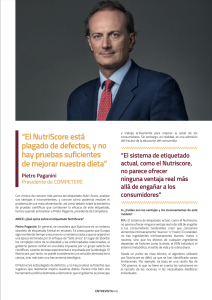The failure of NutriscoreINTERVIEW BY PIETRO PAGANINI
- 12 July 2023
- Posted by: Competere
- Categories: Empowering Consumers, highlights, News

Pietro Paganini was interviewed by the Spanish magazine of ANICE, Asociación Nacional de Industrias de la Carne de España. In the interview, he talks about the Nutriscore labelling system, analysing its advantages and disadvantages and proposing effective solutions to solve the problem of bad nutrition.
Read the English translation below or the original on the ANICE website >>>
What is your opinion on Nutriscore labelling?
The Nutriscore is widely considered an outdated front-of-package labeling system. It is concerning that Europe continues to invest time and resources into a defunct system that originated from an era dominated by the one-size-fits-all approach. Rather than addressing the complex challenges of obesity and related diseases, the government appears to be relying on a diet imposed by an elite group of scientists, lacking an experimental basis and driven by ideology. The Nutriscore, therefore, cannot be viewed as a scientifically derived solution, but rather as an ideological tool.
The Nutriscore is riddled with flaws, and there is insufficient evidence to suggest that it genuinely improves our diets. It appears to be more of a political tool aimed at demonstrating that the government cares and is actively working towards improving consumer health. However, in reality, it is an admission of the failure of consumer education.
What are the advantages and disadvantages of this model?
The current labelling system, such as the Nutriscore, seems to offer no real advantage beyond misleading consumers into thinking they are consuming inherently “good” or “bad” food. In reality, there are no intrinsically good or bad or neutral ingredients—instead, the effects of any ingredient depending on factors such as dosage, individual DNA, metabolic system, lifestyle, and daily routine.
From a technical standpoint, the algorithm used by the Nutriscore is weak, as several limitations have been identified. For instance, it is based on a fixed 100-gram portion, which fails to account for variations in serving sizes or individual dietary needs.
Do you think this system is able to solve the problem of poor nutrition? Why?
Let’s delve into logical reasoning. It is widely recognized that obesity and poor nutrition are influenced by a multitude of factors, extending far beyond the three ingredients that the Nutriscore focuses on. Our lifestyle choices, in particular, play a significant role in driving obesity and unhealthy eating habits. If we were to accept the validity of the Nutriscore algorithm, then logically we should apply a similar approach to all objects and tools in our lives that contribute to obesity.
The underlying message here is that combating poor nutrition requires comprehensive education and empowering consumers with knowledge and choices. Simply relying on a labelling system like the Nutriscore is insufficient.
In this sense, what would be the tools to solve this problem?
Personalized diets indeed hold great potential as a solution to address individual nutritional needs. With real-time information about their physical requirements (such as vitamins, proteins, and fats) as well as psychological factors (such as happiness and socialization), consumers can make informed choices about what they should eat. By considering vital parameters such as DNA, microbiota, metabolism, and daily lifestyle, individuals can tailor their diets accordingly. Artificial Intelligence (AI) can play a significant role in assisting with these choices by analyzing data and providing personalized recommendations.
It is worth noting that governments and scientists may express concerns about personalized diets because of the fear that it could lead to uninformed choices or unhealthy habits. However, the intent behind personalized diets is to empower consumers, giving them the freedom to make educated decisions about their own health. By providing the necessary information and tools, governments can support individuals in making responsible choices that align with their personal needs and preferences.
What scientific evidence currently exists on the effectiveness of this type of labelling?
If we consider the Nutriscore, there is currently a lack of conclusive evidence regarding their effectiveness. As for the more stringent Chilean black dot system, which some may describe as overly restrictive, there are concerning results. Low-income individuals may find it difficult to afford the relatively more expensive “healthy” products. Furthermore, despite initial enthusiasm, consumers tend to revert back to consuming “unhealthy” products simply because they enjoy them.
The real challenge and potential threat is that if these systems are proven to be ineffective, there is a possibility that governments and influential scientists may advocate for even stricter regulations, akin to those seen with tobacco.
Is NutriScore labelling harming the food industry and the consumer in what way?
Indeed, the Nutriscore system can be seen as a commercial tool that enjoys support from governments and a significant number of multinational corporations. These corporations often possess extensive product lines and can easily adapt or create new products that align with the desired healthy green status. This allows them to create a standardized, universal product akin to the iPhone, offering the same taste and characteristics to consumers worldwide. In essence, we can refer to this phenomenon as the “iphonization” of food.
However, the implications of the Nutriscore system extend beyond multinational corporations. Small and local producers, who may have products deeply rooted in tradition and local culture, will be compelled to reformulate their offerings in order to compete on the health front. Unfortunately, not all products can be easily reformulated without compromising their authenticity. As a result, the Nutriscore system may inadvertently contribute to the erosion of traditions and local diets in favor of globally standardized products.
.
Click on the image to read the article in Spanish:
Imagine credits: courtesy of Il Sole 24 Ore >>>


